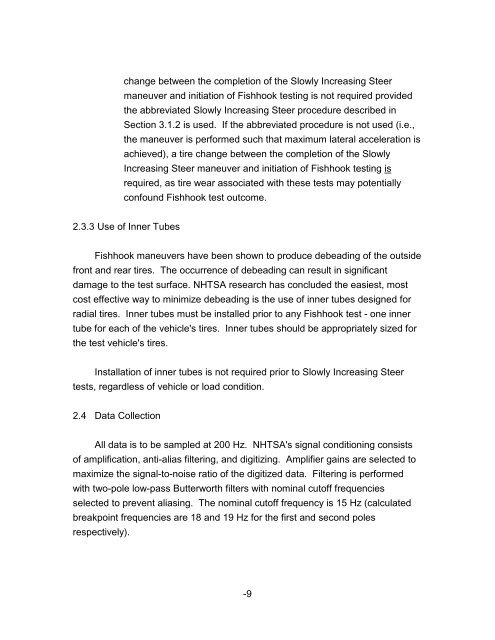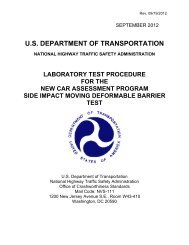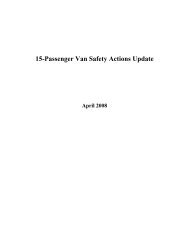Fishhook Maneuver Test Procedure - SaferCar.gov
Fishhook Maneuver Test Procedure - SaferCar.gov
Fishhook Maneuver Test Procedure - SaferCar.gov
Create successful ePaper yourself
Turn your PDF publications into a flip-book with our unique Google optimized e-Paper software.
change between the completion of the Slowly Increasing Steer<br />
maneuver and initiation of <strong>Fishhook</strong> testing is not required provided<br />
the abbreviated Slowly Increasing Steer procedure described in<br />
Section 3.1.2 is used. If the abbreviated procedure is not used (i.e.,<br />
the maneuver is performed such that maximum lateral acceleration is<br />
achieved), a tire change between the completion of the Slowly<br />
Increasing Steer maneuver and initiation of <strong>Fishhook</strong> testing is<br />
required, as tire wear associated with these tests may potentially<br />
confound <strong>Fishhook</strong> test outcome.<br />
2.3.3 Use of Inner Tubes<br />
<strong>Fishhook</strong> maneuvers have been shown to produce debeading of the outside<br />
front and rear tires. The occurrence of debeading can result in significant<br />
damage to the test surface. NHTSA research has concluded the easiest, most<br />
cost effective way to minimize debeading is the use of inner tubes designed for<br />
radial tires. Inner tubes must be installed prior to any <strong>Fishhook</strong> test - one inner<br />
tube for each of the vehicle's tires. Inner tubes should be appropriately sized for<br />
the test vehicle's tires.<br />
Installation of inner tubes is not required prior to Slowly Increasing Steer<br />
tests, regardless of vehicle or load condition.<br />
2.4 Data Collection<br />
All data is to be sampled at 200 Hz. NHTSA's signal conditioning consists<br />
of amplification, anti-alias filtering, and digitizing. Amplifier gains are selected to<br />
maximize the signal-to-noise ratio of the digitized data. Filtering is performed<br />
with two-pole low-pass Butterworth filters with nominal cutoff frequencies<br />
selected to prevent aliasing. The nominal cutoff frequency is 15 Hz (calculated<br />
breakpoint frequencies are 18 and 19 Hz for the first and second poles<br />
respectively).<br />
-9











